MALLARD : Anas platyrhynchos
Where to see them : Almost any open water and sometimes even on lawns or under trees when the weather is inclement.
Mallard are very common around West Dunbartonshire's waterway and can also be encourntered some distance from water when they seek respite from inclement weather. They don't even mind if the water is in a natural area or an urban park. And so they are the most likely water bird we will see.
They enjoy being fed bread by children, but the RSPB is quick to emphasise that this is not recommended. Contrary to popular belief, their favourite food includes: seeds, aquatic vegetation, acorns, berries, plants, insects and shellfish. Although they appear to enjoy eating bread, this can actually harm them, and reduce the water quality. Bird seed or special duck food makes a great alternative. They do not dive down under the water, but instead tend to tip forward with their tails in the air. They also forage for food on land, around the waters edge and in farmers’ fields.
The mallard is the ancestor of most domesticated farmyard ducks. Male and female mallards looks so different that they were originally thought to be different species.
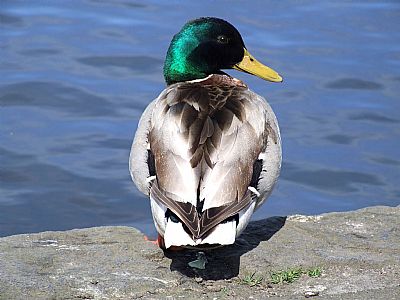
The male, the drake, has a very distinctive irridescent green head and yellow bill.
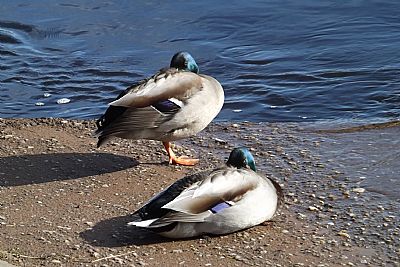
Male mallard, drakes, can be quite competitive and you may see them explode into wild splashing about, with the one that backs down flying off with the "winner" following. But most of the time they get on very well and you are more likely to see mixed groups. Here are two drakes catching a nap. Well, look closely and you will see that they are peeking at this photographer. Can you sleep on one leg with someone watching?
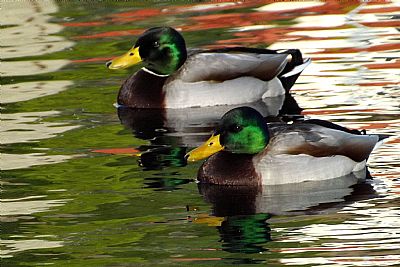
Elegance is....
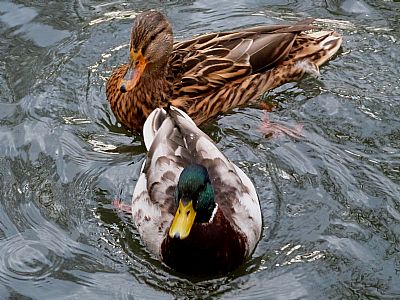
Mr and Mrs in January
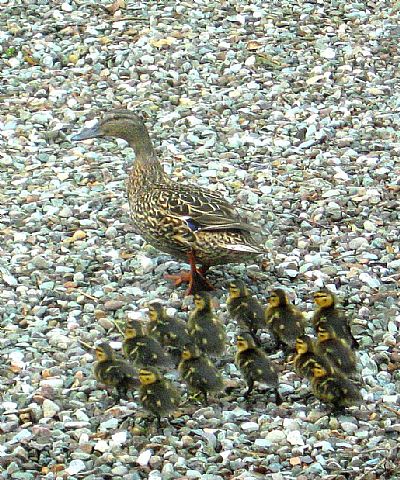
The female is mottled brown. This offers excellent camouflage such as when hiding her brood of ducklings. This photo was taken onto a gravelled back yard above Renton far from the river or even inland water. Mum and babies blend in well.
Mallard are known to lay between 8 and 13 eggs. The numbers dwindle as they are lost to predators or strong currents. Here we see 13 young together. Being far from the water suggests that they are all hers and not an accumulated creche including young of others. They still can't fly. Perhaps laying so far from the usual environment has given them a headstart.
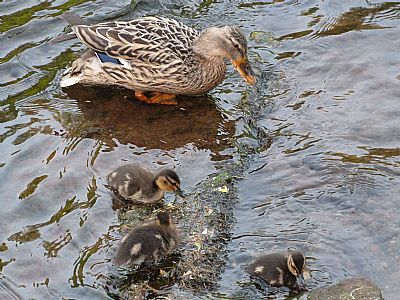
Its the first week of May 2025 and the first new batches of ducklings are appearing. This one consists of 5.
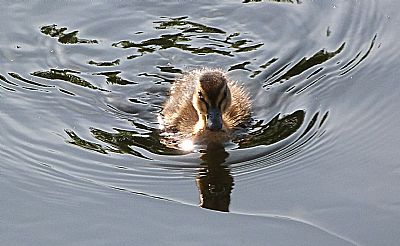
One of the new brood on the Leven in May.
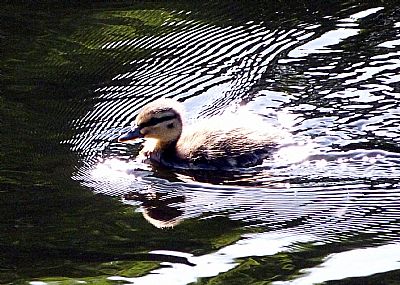
These were some of a flotilla of 7.
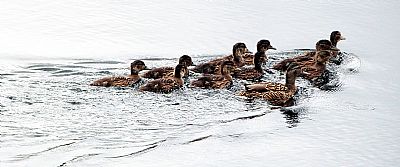
Here is a family of 10 ducklings with their mum one June morning. Judging from their similarity in size, these were all from the same brood, although sometimes we see "creches" of accumulated young.
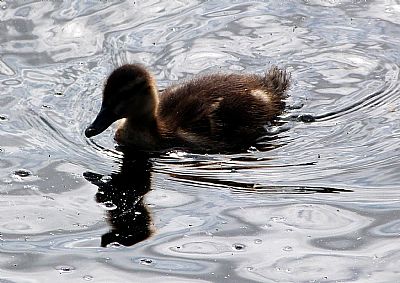
Growth spurts that outdo any human child.
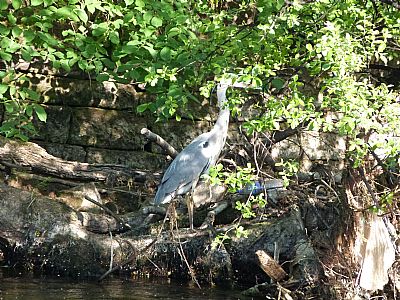
The most common young family is of 5 ducklings. We sometimes see more and some families accumulate into larger creches with the young of other parents. But these reduce over the ensuing weeks. Nature is violent. Whether by predators as this heron stalking ducklings or eating the eggs or even swift currents, life can be uncertain.
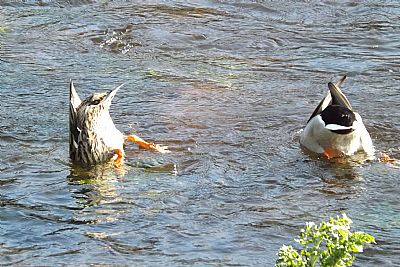
There's breakfast down there somewhere.......
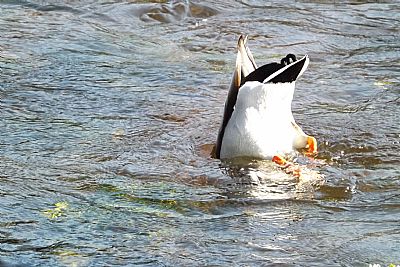
.......got some... got some! Yummy slimy stuff.
Mallard will eat seeds, acorns and berries, plants, insects and shellfish. Upending like this enables them to eat water grass together with any aquatic bugs that they come across.
A question sometimes asked is how deep a mallard can dive. From the bums-up images above, you will see that mallard are dabblers not divers, but the exceptions occur. The answer to the question “How deep can mallards dive?” is quite straightforward: mallards generally do not dive deeply at all. These familiar ducks are dabbling ducks, not diving ducks, which means their feeding behavior and physical adaptations are geared towards surface feeding and shallow water exploration. Unlike their diving cousins, mallards primarily feed by tipping forward in the water, grazing on underwater plants with their heads submerged while their rear ends remain above the surface. This characteristic behavior, known as dabbling, limits their foraging depth considerably. [Environmental Literacy].
So it is with some surprise that we find a mother and her two ducklings diving on the Leven one summer. They seemed to have found some particularly yummy water weed deeper than a usual bums-up dabble would give access to. They dived again and again in about the same spot. Not that deep, but proper diving well below the surface. We saw others diving later that week within the briskly flowing central current. They just didn't care about the rules concerning mallard not diving. Perhaps too, it is a seasonal thing. Perhaps much sought after waterweeds below the surface are at their best in summer.
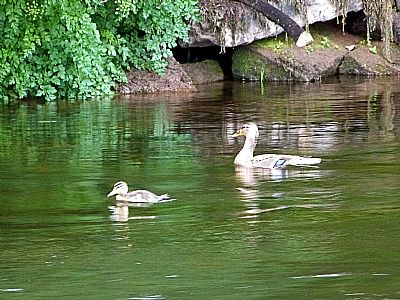
One of the two ducklings stays close to mum. The other one is below the surface.
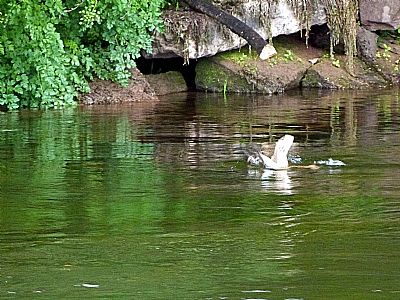
Not as dignified as a true diver, but mum is nevertheless upended and down to join her two ducklings. There is one just to her right and the other a little to the front left.
It is nearly mid-May. There are lots of mallard drakes about (males). But no hens (females). Why? Well they must be out of sight on their nests incubating the egss. Mallards start to pair up in October and November, and start to nest in March. The RSPB notes : The female builds a nest from leaves and grasses and lines it with down plucked from her breast. Eggs are laid between mid-March and the end of July. The normal clutch is about 12 eggs, laid at one to two day intervals. After each egg is added, the clutch is covered to protect it from predators.
Males, the drakes, can be very competitive and boisterous during the mating season, but the role of the male is almost over once the clutch is laid. He remains sexually potent for a while in case a replacement clutch is needed, but gradually loses interest and joins other males to moult. The females, the hens, meanwhile are very busy and generally out of sight.
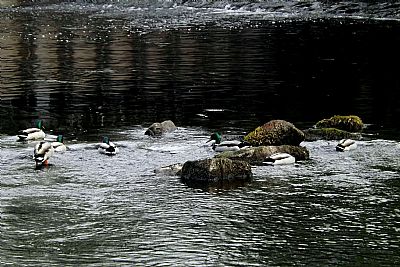
A boys club of mallard drakes.
The drakes take no interest in the incubation of the nests. But they do their bit in other ways. The laying period is very stressful for the female as she lays more than half her body weight in eggs in a couple of weeks. She needs a lot of rest and depends heavily on her mate to protect her and their feeding and loafing areas.
By late May we see some drakes along the Leven towpath and they seem to agitated about us being to close to something - very likely a hidden nest.
Some ducklings are out on the water by now.
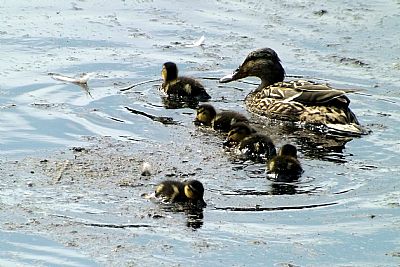
A mallard mum keeps a close eye on four ducklings. She has taken them to a quiet spot within the eddies, but this also has am accumulation of debris such as leaves and grass. She selects bits and offers them to the babies so teaching them what to eat.
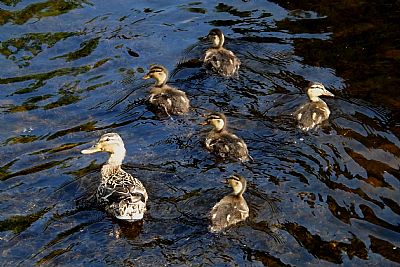
The second week in June and the ducklings are growing fast.
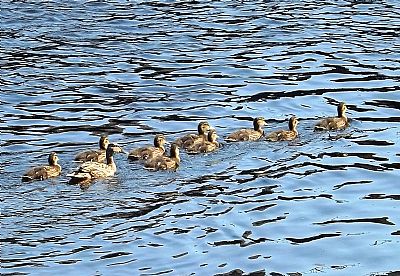
So far we have only noticed mum mallard with up to 5 ducklings. Then in mid-June these were padding about the Leven. All apparently the same age. But are they all the same brood? Or perhaps this is a mallard duckling creche combining 2 broods. Only one mum seen though.
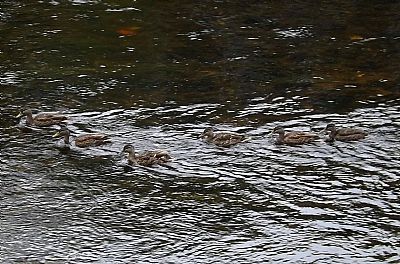
In just a few weeks the ducklings' growth is phenomenal.
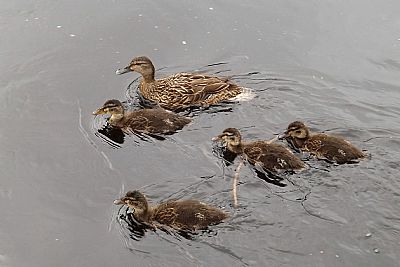
A relatively late brood in late-August. But a more confident mum bringing them up to people in case of some food.
Identifying birds can be a tricky business. Most birds vary in plumage across their growth and seasonally. Mallard are a species that can confuse us more than most. For instance, it is not uncommon to see a completely white duck amongst them. So is it a domestic duck that has taken a shine to living a wild life with wild company? Or is a hybrid between species? Or perhaps a visiting species not usually found in the UK?
Or is it an albino mallard?
Alternatively, is it a leucistic variant? A what? Have a look at the photos below and see if you agree that this is one. Any comment of course can be made through this website's comments section. But first let's explain leucism.
Leucism is a rare genetic condition that cuses partial loss of pigmentation in birds, including ducks. Unlike albino birds, which have no pigmentation at all, leucistic birds still have some colouring in their feathers and skin, but it is usually much paler than normal. Leucistic ducks are usually all white or mostly white with only a few coloured feathers. [Save the Eagels International]. More about this can be found through the link bekow.
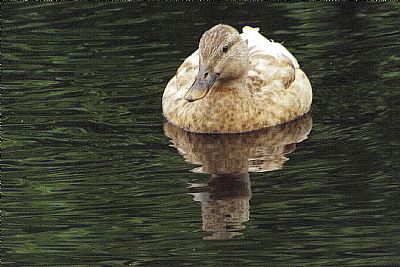
This and the following photo were taken at the Helensburgh skating pond in August 2023 of the same bird. It is simply just another brown duck? Look carefully and you will notice that the colouration is similar to a gadwall, but the bill form is the same as a mallard female. While this also be an immature mallard female going through a plumage change, much of the plumage is much paler and the bill colour differs. Otherwise it is quite happy living with other mallard.
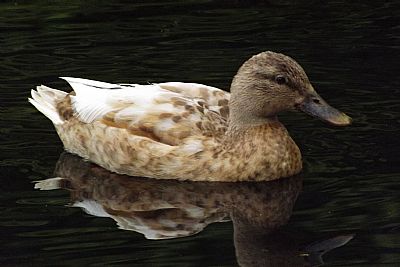
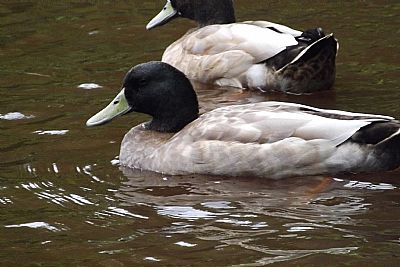
This picture was taken near Pitlochry in September 2023. There were quite a lot of regular mallard and a few of these. They appear to be variants of the regular mallard with perhaps some leucism creating very light plumage over most of the body - the head being generally darker. These are males as compared to females in the previous pictures.
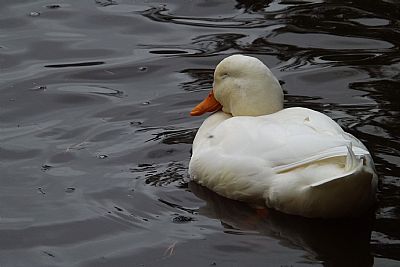
So is this an albino mallard, an extreme case of leucism or an errant domestic duck? The answer is that we cannot be sure. Domestic ducks like this do descend from mallards and some may choose to live amongst them. Although not common, many of us have seen one or two. This was taken on the River Tummel near Pitlochry at the same place and time as the previous example.
ENVIRONMENTAL; LITERACY website : https://enviroliteracy.org/how-deep-can-mallards-dive/
RSPB : https://www.rspb.org.uk/birds-and-wildlife/wildlife-guides/bird-a-z/mallard/breeding/
SAVE THE EAGLES INTERNATIONAL website: This covers leucism in ducks.
SCOTTISH WILDLIFE TRUST : https://scottishwildlifetrust.org.uk/2020/03/the-secret-life-of-mallard-ducks/
TALKING BIRDS : https://www.talking-birds.co.uk/the-ultimate-guide-to-mallards-everything-you-need-to-know/
THE WILDLIFE TRUSTS : A good reference to identify dabbling ducks. https://savetheeaglesinternational.org/leucistic-duck/ : https://www.wildlifetrusts.org/wildlife/how-identify/how-identify-dabbling-ducks
A good reference to identify diving ducks : https://www.wildlifetrusts.org/wildlife/how-identify/how-identify-diving-ducks
https://www.wildlifetrusts.org/wildlife-explorer/birds/waterfowl/mallard

